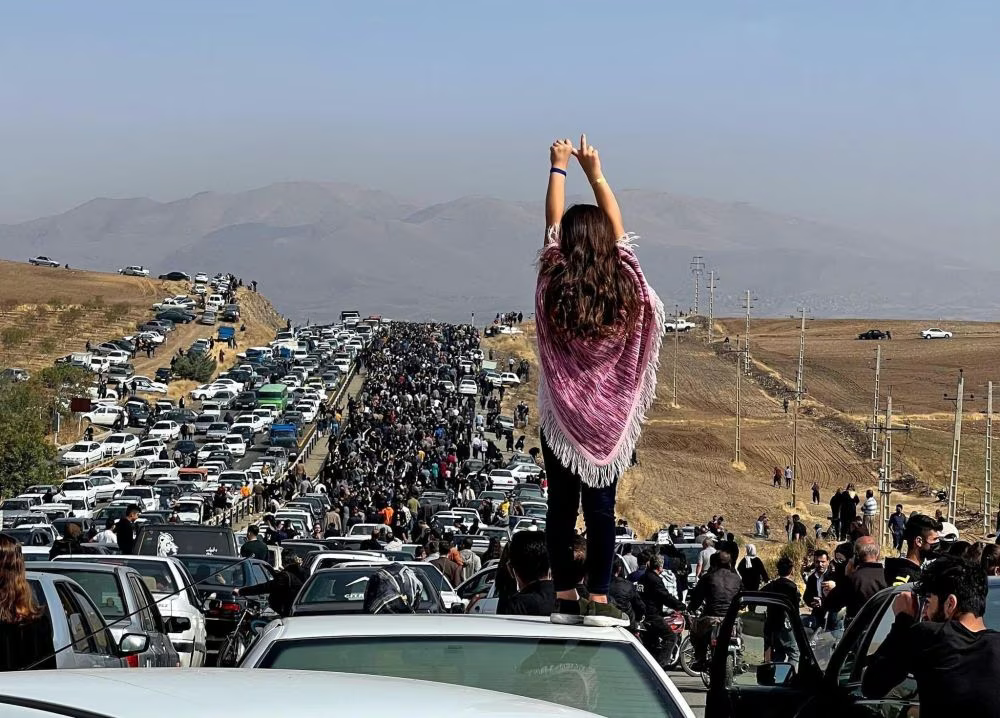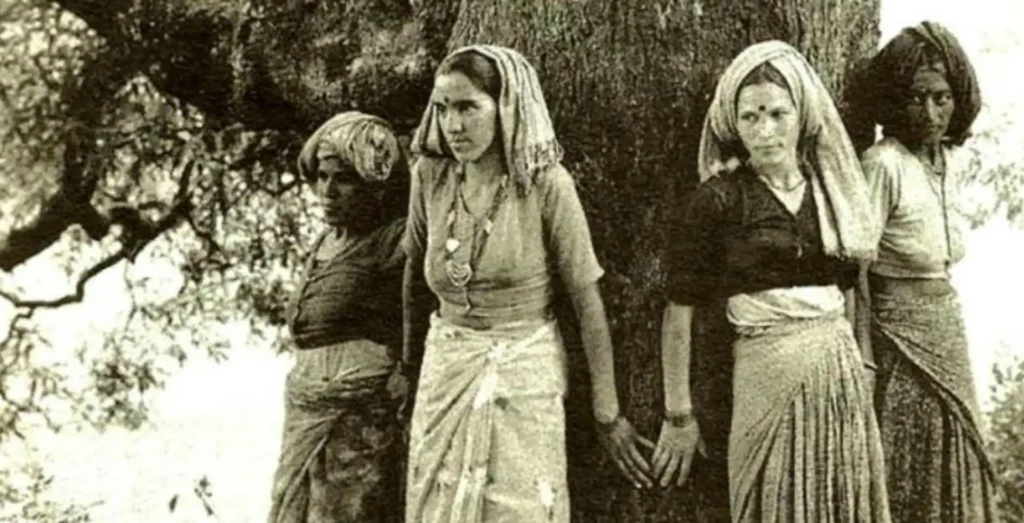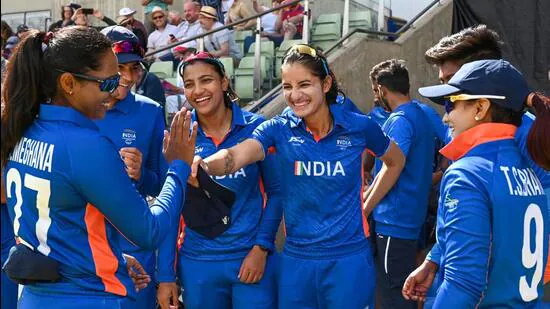On the 40th day after Mahsa Amini’s death in police custody for being ‘improperly’ veiled, thousands ignored road closures and marched to her grave in Saqez, Iran.
The protests are being led by women. They are burning hijabs, cutting their hair, dancing and chanting: “Women, life, freedom”.
Despite a brutal crackdown that has, according to one estimate left 222 dead, amongst them women and children, the protests show no sign of abating, spreading instead to alarger group of students and men who are demanding regime-change.
Will a country where half the population is aged below 40 force the regime to buckle, or will the state succeed in crushing out these voices? It’s too early to say.

1000s of people walking towards #MahsaAmini’s cemetery in #Saqez (Source: Twitter/@Omid_M)
But if history teaches us one thing, it is this: When women come out onto the streets to protest, change often is the outcome.
Women have always protested– perhaps few men understand oppression the way most women do. In India, they marched during the Independence movement. They marched against dowry and sati. Not every protest leads to change, but it does serve to send the message that the status quo cannot continue.
Some examples from India:
Chipko Movement, 1973
The non-violent agitation aimed at protecting trees is best remembered for the collective mobilisation of women, perhaps because they were most affected by lack of firewood and drinking water, and inaccessibility to fodder caused by deforestation and government policies.
Triggered by Gandhian social activist Chandi Prasad Bhatt and carried forward by Sunderlal Bhaguna, the movement is also remembered for the leadership of women like Gaura Devi who in March 1974 galvanised a group of 27 women to fend off loggers and contractors at Reni village in Chamoli by literally hugging the trees that were to be felled.

Chipko Movement, one of the strongest movements to conserve forests in India. (Source: Wiki Media Commons)
Gaura Devi’s success after a four-day stand-off electrified the movement as it spread with women taking up other social issues including anti-alcoholism, setting up cooperatives for fodder production and replanting degraded land.
In 1980 then Prime Minister Indira Gandhi announced a 15-year ban on the felling of trees.
The December protests, 2012
The gang-rape and subsequent death of a medical student in Delhi on December 16, 2012 sparked “revulsion and anger … where women regularly face sexual harassment and assault, and where neither the police nor the judicial system is seen as adequately protecting them,” noted the New York Times.
The anger on the street prompted the then Congress-led government to set up a commission headed by the late Justice J S Verma. In less than a month, its sweeping recommendations expanded the definition of rape and criminalised other forms of violence against women, including acid attacks.
Farmer protest, 2020
Described as the largest protest in the world, the year-long agitation against three agriculture law passed in September 2020, saw large-scale participation by women, remarkable really as the epicentre of the protest was Haryana, a state known for its ingrained patriarchy.
“Rural women experience a large-scale exclusion in land ownership and operation rights,” write Jagmati Sangwan and Shamsher Singh in Economic and Political Weekly. The introduction of the farm laws “aggravated the apprehensions of the already crisis-ridden peasantry.” Moreover, a new generation of women in Haryana had already been asserting their agency through education and sport. Joining the protests was a natural progression for them.
It wasn’t easy. Activist Nodeep Kaur told me how she had to fight to make herself heard. “I was the last to be given the mike,” she said. “The attitude was, ‘who is this Dalit young woman’?” When it was her turn to speak, the men who had already spoken would walk off the stage. Nevertheless, she stood her ground.
The women helped clear obstacles, including barricades set up by the police. They mobilised rations including milk, vegetables and cooked food for the camps. As the months wore on, they took on a more active role, joining protestors headed to Delhi and other protest sites, picketing and gheraoing government offices and police stations, “asserting their right to protest, public space, and dignity” write Sangwan and Singh.
In November 2021, the government repealed the farm laws.
Shaheen Bagh, 2021
In the end it was the Covid pandemic that brought to a close the 100-day protest against the government’s proposed Citizenship Amendment Act. Remarkable about the protest was the presence of women—mothers with babies, domestic workers, schoolgirls, grannies—most of them Muslim. “Muslim women don’t come out on the street easily,” Sakina Parveen, a social worker who lives near Shaheen Bagh told me. “But they understand this issue and this is why they are here in such large numbers.”
The anti-CAA protest quickly spread to other parts of India from Assam to Karnataka. Shaheen Bagh was the epicentre for women to register their anger at what they saw was an attempt to foist an unjust law. Their presence through that cold winter belied the narrative of the ‘oppressed’ Muslim woman.
But on March 23, 2020, when the prime minister announced a nation-wide lockdown due to Covid, it was time to pack up and go home.
Two years after the CAA was passed by Parliament, the ministry of home affairs is yet to notify the rules that will govern it.

GOING PLACES

Hers was the reassuring face on television during the height of Covid, telling us there was no end to the pandemic and we just had to learn to live with it. Now, Gagandeep Kang , microbiologist at the Christian Medical College, has been elected to the National Academy of Medicine for her “outstanding contributions to understanding and improving child health”. Of the 100 new members for the 2022 batch, Kang is the only scientist from Asia and the third Indian ever to be elected to the Academy.
SEEN AND HEARD
“If she had no wish to do her household activities, then she ought to have told it prior to the marriage so that the bridegroom can rethink about the marriage itself.”
In a country where women spend as much as eight times more (335 minutes) on housework–46% of their waking hours–compared to 40 minutes chipped in by men, Justices Vibha Kankanwadi and Rajesh S Patil of the Aurangabad bench of the Bombay high court seem to have their own ideas about the place of a wife in a marriage.
BOOKSHELF

Help! The condom broke.
What determines penis size?
Umm…how does anal sex work?
For five years, sex educator Leeza Mangaldas has been dishing out gyan on sex and all things related – consent: yes; pleasure: yes, please – to 879,000 followers on Instagram (@leezamangaldas) and on her podcast on Spotify.
Now, she has her first book out and it’s available as a paperback, an e-book and an audio book. “In many ways it’s the book I wish I myself could have had, with which to learn about sex and the body. As a young, unmarried Indian woman trying to navigate my own sexuality, sexual health and relationships, I found there to be such a lack of easily accessible and culturally relevant information and resources about sex,” she posted.
The Sex Book: The joyful journey of self-discovery by Leeza Mangaldas, Harper Collins, Rs 311 on Amazon.
STORIES YOU MIGHT HAVE MISSED
The good news…pay parity for women cricket players

It’s been a good month for India’s women cricketers. First came the announcement of the women’s Indian Premier League slated for early 2023. Then, on Thursday, the Board of Control for Cricket in India (BCCI) said women cricketers will finally be paid the same match fee as men for international matches. After New Zealand Cricket, the BCCI is now the second cricket board to announce pay parity.
‘Amazing’, ‘historic’, ‘red-letter day’ were some ofthe epithets despite the sobering reality that women’s collective match earnings sill won’t come close to that of the men simply because they play far fewer matches. Rasesh Mandani does the math: A male international player will still make Rs 10.5 crore compared to Rs 3 crore that a woman international player will take home.
There’s also the tricky issue of annual retainers where the pay gap remains huge. India’s best-paid women contracts are valued at Rs 50 lakh, half that of the lowest-ranked men’s contract, and 14 times less than what a Grade A male player is worth.
The BCCI says this is only the start. It is, one worthy of a cheer.
Nursing home fined for failure to report on foetal disability
Failure to inform a couple about their child’s physical deformities during pregnancy despite three ultrasound tests on the mother has resulted in the award of Rs 10 lakh as compensation on the nursing home where the tests were done.
The child was born without a left leg and a right hand. A district consumer court in Odisha’s Jagatsinghpur district has also ordered the nursing home to pay Rs 50,000 to the mother for her mental agony and another Rs 4,000 towards litigation cost.
The court noted that had the couple been informed about the deformities they could have opted for an abortion, legal in India up to 24 weeks of pregnancy in cases where there are serious foetal abnormalities. There is a substantial risk that if the child were born it would suffer from serious disability.
Men who made videos instead of helping bleeding girl face arrest
Kanpur police has lodged an FIR against 15-20 unidentified men for shooting videos of a bleeding 12-year-old girl begging for help. The ghastly incident of voyeurism and apathy in Kannauj led to outrage and the men will now be identified through the videos they shot. The girl was eventually taken to hospital by sub-inspector Manoj Pandey where she is being treated for apparent rape. The man accused of causing the injuries is yet to be apprehended.
FIELD NOTES: Making cities matter to women
Cities have traditionally been designed for able-bodied men rather than women, girls, sexual and gender minorities and people with disabilities.
Now, a toolkit issued by the World Bank seeks to rectify that imbalance. With economist Mitali Nikore as the lead writer, the paper urges policy makers to assess the ground situation to understand gender differences in mobility patterns, understand safety concerns and integrate a gender lens in new and existing policies and plans.
Read here.
AROUND THE WORLD
In Zealand, the number of women MPs has for the first time exceeded the number of men, 60 to 59, reports The Washington Post. The milestone places the country among a half-dozen nations, including Cuba, Mexico, Nicaragua, the United Arab Emirates and Rwanda, that can this year claim 50% female representatives in Parliament.
In the UK, Carmen Callil, the publisher and writer who championed women writers has died of leukemia aged 84, reports The Guardian. Callil founded the feminist imprint, Virago Press where she published such contemporary bestsellers as Margaret Atwood, Maya Angelou and Angela Carter.
Taylor Swift has edited the video for Anti-hero, one of the tracks in her new album Midnights, days after its release when it broke records for the most-streamed albums on Spotify. Swift made the change following a backlash over a scene that shows her stepping onto a scale that reads FAT, which critics said was ‘fatphobic’. BBC has the story.
| Were you forwarded this email? Did you stumble upon it online? Sign up here. |
| That’s it for this week. Do you have a tip or information on gender-related developments that you’d like to share? Write to me at: namita.bhandare@gmail.com. |